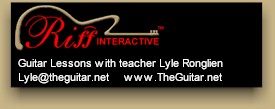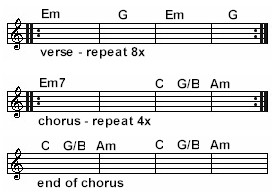
Jam Sessions - Rock
Style
Lesson 1
Lyle: Turn your amp up all the way and jam! Learn
chords, rhythm riffs, scales and modes, lead riffs, theory, and solos as you jam
along with the jam tracks in a variety of rock styles.
These lessons are
great for the student who is looking for new things to practice, new theory to
apply, new ways to improvise using modes, and perhaps best of all, something new
to jam to.

Jam In
Em
Lyle: Here's your first chord chart and
jam track for this lesson:
chord chart

Lyle:
Notice this jam in Em has two sections, a verse and chorus. Here's the simple,
yet heavy verse riff:
Lyle:
The verse riff is pretty simple. Try using a medium overdrive setting on your
amp, and the bridge pickup on your guitar. Don't use any effects, keep it dry
and tight sounding.
Lyle: The chorus section of the jam changes to a
clean tone with a delay setting of 428ms. The chorus section looks long but it's
just a repeating riff with a little ending to it.
Lyle:
That duration of a delay gives you a quarter note echo at this tempo setting of
140bpm. To calculate bpm into ms, simply take 60,000 divided by (tempo) 140bpm =
428 for your quarter note delay setting.
Lyle:
When improvising over the verse section in Em, the E Dorian minor scale is cool
to use:
ZZ: Dorian is a
minor mode correct?
Lyle: Yes, that is correct. The Dorian minor mode
is the 2nd mode of the major scale. The E dorian minor mode is the 2nd mode of
the D major scale.
Lyle: Also, the E minor blues scale is always a
great scale to use for improvising against a minor jam like this:
Lyle:
Here's a solo I made from the E minor blues:
ZZ: Is it a rule of thumb to always
improve a minor scale over a minor chord
Lyle: That's a safe rule,
yes.
Paul_B: OK question, C major scale
= C,D,E,F,G,A,B. So D Dorian is just D,E,F,G,A,B,C For the minor, is this
right?
Lyle: Yes! D to F is a flatted 3rd. The Dorian is:
1, 2, b3, 4, 5, 6, b7
depar: I like hitting the 6th in E dorian for this
jam track
Lyle: Me too. In bar 8 of the solo above is
the 6th degree found in the E Dorian.
Lyle: When improvising over the chorus section,
you have to change from the Dorian minor to the natural minor because of the C
note in the chorus. (The Dorian minor scale has a C# in it)
Lyle: To
sum things up a little, you can use the E minor blues scale over both the verse
and chorus sections. Use the Dorian for the verse, the natural minor for the
chorus.
Paul_B:
Ok I think I got it now E dorian minor same as D major just rest or end on the E
am I close?
Lyle: Right.
depar: Lyle, when you think patterns
for E Dorian, do you visualize D Major, or "think" in Dorian?
Lyle:
I might do both, switch back and forth as my fingers get ready to change
into another pattern/mode.
flathead: Does emphasizing
the 'A' note in the beginning of the solo add tension because an 'A' note is not
in the E minor
chord?
Lyle: flathead, good
question, I liked starting on that note for that very reason, the A note isn't
in the chord and makes you want to resolve to another note. It almost sounds
like a wrong note but it's not. A is the 4th in the Em scale, also could be a
sus4 note in the chord.
Buud: Lyle - How do you get such
long sustains on your solo? Just lots of gain on the amp? What kind of amp are
you using. What kind of tube is in it? I have a Univalve and can put in 6L6,
EL34, 6550, and 6V6.
Lyle: To get good sustain I
pluck the note hard and add a little vibrato. I use a Rocktron Voodu valve
preamp and record direct to the soundcard for these
lessons.

Jam in
F#m
Lyle: Here's another jam.
Lyle: This type of chord progression is popular
with heavy rock. Here's your new jam track to work on:
chord
chart

Lyle: Go
for the bridge pickup and a medium overdrive setting again, no effects. You want
to palm mute this riff:
Lyle:
The cool scale to use again is the ever popular minor blues scale:
Lyle:
When I see a progression like this that has a chord a half step above the first
chord, I lean toward using the Phrygian minor scale because it too has a note in
it that is a half step above the first note in the scale.
Lyle:
Notice that the second note of the Phrygian minor scale is a G note, just like
in the chord progression.
Lyle: The Phrygian minor scale is a "mode", the
third mode of the D major scale. So you can also play any notes from the D major
scale too when improvising to this jam track!
Lyle:
Look at the 1st and 2nd strings of the F# Phrygian minor scale, the finger/fret
patterns are the same making it easy to play fast. Try this little riff using
either hammer-ons or pull-offs:
Lyle:
Repeat them over and over, going faster and faster like in this video example:
Lyle:
Here's a solo made from the Phrygian minor scale and the D major scale. Bar 4
has a descending D major scale riff:
radica: Do you bar your one finger over
the 14's?
Lyle: Yes
rad.
Lyle: There's a pinch harmonic (P.H.) note right
near the end of the solo. You pick the string with the pick and the side of your
thumb at the same time.
Lyle:
Any questions?
doulos: Question about
the Pinched Harmonics - Should you shoot for a particular harmonic or will it
work out all the same?
Lyle: doulos, notice in the
video I move my picking hand around the string to get different pitches of
harmonics.
Jim: Question - Do you lay something down
(improvise) and then notice the mode used, or do you consciously "plan
ahead"? I understand the theory, it's the practical approach that eludes me...
:-)
Lyle: Jim, using modes gives you two things, a
different approach to a melody, and a new place/pattern to play on the neck.
That's how I work it MOST of the
time.
Jim: I guess I'm asking if you look at the rhythmic
progression and choose a mode "logically" before laying pick to string... Or let
creativity flow and post analyze?
Lyle: Jim, It depends, once
you know what chords are being used, you can apply the correct mode the relates
to the key you're in. Stick around for more lessons with my here because I'll be
showing little mode tricks along the way in these series of Jam
Sessions.
Lyle: All
the Jam Tracks from this series are available in high quality MP3 download from
my web site TheGuitar.net.
|
<< load notation from left
|